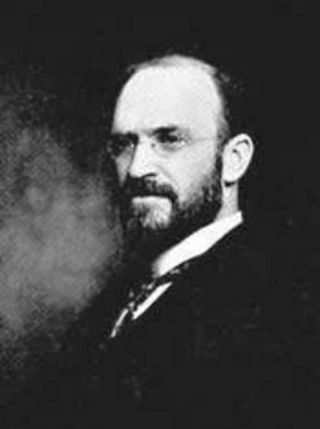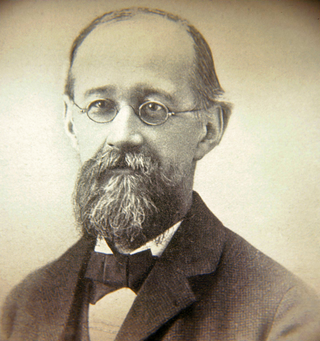The Bliss bibliographic classification (BC) is a library classification system that was created by Henry E. Bliss (1870–1955) and published in four volumes between 1940 and 1953. Although originally devised in the United States, it was more commonly adopted by British libraries. A second edition of the system (BC2) has been in ongoing development in Britain since 1977.

The Dewey Decimal Classification (DDC), colloquially known as the Dewey Decimal System, is a proprietary library classification system which allows new books to be added to a library in their appropriate location based on subject. It was first published in the United States by Melvil Dewey in 1876. Originally described in a 44-page pamphlet, it has been expanded to multiple volumes and revised through 23 major editions, the latest printed in 2011. It is also available in an abridged version suitable for smaller libraries. OCLC, a non-profit cooperative that serves libraries, currently maintains the system and licenses online access to WebDewey, a continuously updated version for catalogers.
The Library of Congress Classification (LCC) is a system of library classification developed by the Library of Congress in the United States, which can be used for shelving books in a library. LCC is mainly used by large research and academic libraries, while most public libraries and small academic libraries use the Dewey Decimal Classification system. The classification was developed by James Hanson, with assistance from Charles Martel, in 1897, while they were working at the Library of Congress. It was designed specifically for the purposes and collection of the Library of Congress to replace the fixed location system developed by Thomas Jefferson.

A library classification is a system used within a library to organize materials, including books, sound and video recordings, electronic materials, etc., both on shelves and in catalogs and indexes. Each item is typically assigned a call number, which identifies the location of the item within the system. Materials can be arrange by many different factors, typically in either a hierarchical tree structure based on the subject or using a faceted classification system, which allows the assignment of multiple classifications to an object, enabling the classifications to be ordered in many ways.

Melville Louis Kossuth "Melvil" Dewey was an influential American librarian and educator, inventor of the Dewey Decimal system of library classification, a founder of the Lake Placid Club, and a chief librarian at Columbia University. He was also a founding member of the American Library Association. Although Dewey's contributions to the modern library are widely recognized, his legacy is marred by his sexual harassment of female colleagues, as well as his racism and antisemitism.

A library catalog is a register of all bibliographic items found in a library or group of libraries, such as a network of libraries at several locations. A catalog for a group of libraries is also called a union catalog. A bibliographic item can be any information entity that is considered library material, or a group of library materials, or linked from the catalog as far as it is relevant to the catalog and to the users (patrons) of the library.
Dot-decimal notation is a presentation format for numerical data. It consists of a string of decimal numbers, using the full stop (dot) as a separation character.

Charles Ammi Cutter was an American librarian. In the 1850s and 1860s he assisted with the re-cataloging of the Harvard College library, producing America's first public card catalog. The card system proved more flexible for librarians and far more useful to patrons than the old method of entering titles in chronological order in large books. In 1868 he joined the Boston Athenaeum, making its card catalog an international model. Cutter promoted centralized cataloging of books, which became the standard practice at the Library of Congress. He was elected to leadership positions in numerous library organizations at the local and national level. Cutter is remembered for the Cutter Expansive Classification, his system of giving standardized classification numbers to each book, and arranging them on shelves by that number so that books on similar topics would be shelved together.
A faceted classification is a classification scheme used in organizing knowledge into a systematic order. A faceted classification uses semantic categories, either general or subject-specific, that are combined to create the full classification entry. Many library classification systems use a combination of a fixed, enumerative taxonomy of concepts with subordinate facets that further refine the topic.
This is a conversion chart showing how the Dewey Decimal and Library of Congress Classification systems organize resources by concept, in part for the purpose of assigning call numbers. These two systems account for over 95% of the classification in United States libraries, and are used widely around the world.
The American Library Association and Library of Congress Romanization Tables for Russian, or the Library of Congress system, are a set of rules for the romanization of Russian-language text from Cyrillic script to Latin script.
The National Library of Medicine (NLM) classification system is a library indexing system covering the fields of medicine and preclinical basic sciences. The NLM classification is patterned after the Library of Congress (LC) Classification system: alphabetical letters denote broad subject categories which are subdivided by numbers. For example, QW 279 would indicate a book on an aspect of microbiology or immunology.

Glut: Mastering Information Through The Ages is a 2007 book written by Alex Wright, a writer and information architect for The New York Times. Wright's intention is to provide a broad historical overview of the development of information transmission and organization systems.

Charles Martel was an American librarian responsible for the creation of the Library of Congress Classification; he is often considered to be one of the most influential librarians in American library history.
In library and information science documents are classified and searched by subject – as well as by other attributes such as author, genre and document type. This makes "subject" a fundamental term in this field. Library and information specialists assign subject labels to documents to make them findable. There are many ways to do this and in general there is not always consensus about which subject should be assigned to a given document. To optimize subject indexing and searching, we need to have a deeper understanding of what a subject is. The question: "what is to be understood by the statement 'document A belongs to subject category X'?" has been debated in the field for more than 100 years
Hope A. Olson is Professor Emerita at the School of Information Studies at the University of Wisconsin–Milwaukee. She was previously a professor at the University of Alberta.
Metis is a Dewey-free library classification system developed and implemented in 2011 by Sue Giffard, Tali Balas Kaplan, Jennifer Still, and Andrea Dolloff, the librarians at the Ethical Culture School in New York City. The system places the thinking, interests, information needs and information-seeking behavior of children at its center. It was developed as an alternative to the Dewey Decimal Classification System and the practices which customarily accompany that system in school and public libraries in the United States: namely, the alphabetical arrangement of fiction by author, and the frequent arrangement of biographies in alphabetical order by biographee. The Metis system was designed to encourage productive independent browsing by children, as well as allowing for successful catalog searching by elementary school students.
Jennie Dorcas Fellows, also known as Dorcas Fellows and Dorkas Fellows, was an author and instructor of library cataloging at the New York State Library. Her book, Cataloging Rules, originally published in 1914 as bulletin 36 of the New York State Library School, remains in print in its many editions and formats.
The British National Bibliography (BNB) was established at the British Museum in 1949 to publish a list of the books, journals and serials that are published in the United Kingdom and Republic of Ireland. It also includes information on forthcoming titles. This is the single most comprehensive listing of UK titles. UK and Irish publishers are obliged by legal deposit to send a copy of all new publications, including serial titles, to the BNB for listing. The BNB publishes the list weekly in electronic form: the last printed weekly list appeared in December 2011.
Superintendent of Documents Classification, commonly called as SuDocs or SuDoc, is a system of library classification developed and maintained by the United States Government Publishing Office. Unlike Library of Congress Classification, Dewey Decimal Classification, or Universal Decimal Classification, SuDocs is not a universal system. Rather, it is intended for use only with publications of the Federal Government of the United States. Also, SuDocs does not organize materials by subject, but by the agency that created those materials, making it a provenance-based or archival classification system.





